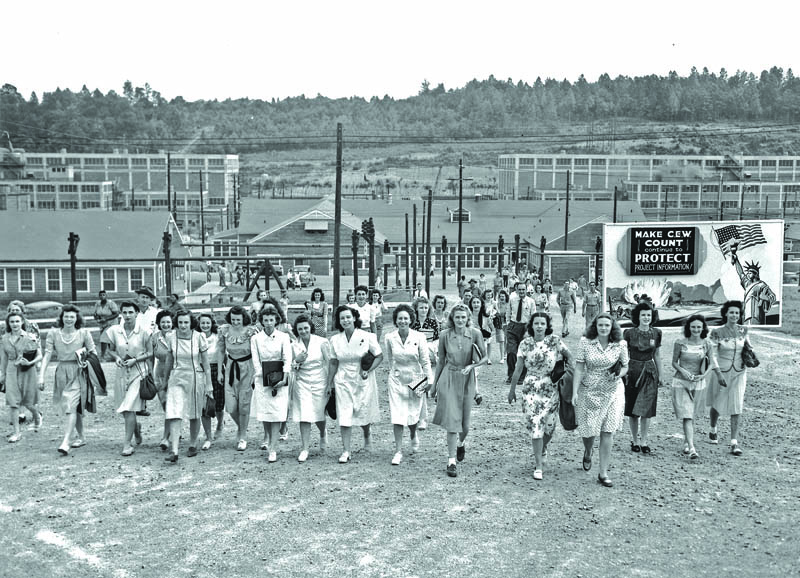Tennessee history for kids
The Crate, the Crew, and the Secret City

After President Roosevelt ordered work to begin on an atomic bomb, the project was given the code name “Manhattan Project” and placed under the command of U.S. Army officer Leslie Groves. Groves chose physicist J. Robert Oppenheimer to be scientific director of the project.
Groves, Oppenheimer and most of the key scientists worked at Los Alamos, New Mexico. Physicists weren’t sure about the best way to create the nuclear reaction in an atomic bomb. Some believed that the best way to do it was by making an element called plutonium; others believe they should use Uranium-235.
The decision was made to create both elements — plutonium in Hanford, Washington, and Uranium-235 at an East Tennessee site that eventually came to be known as Oak Ridge.
In 1942 and 1943, the U.S. government acquired about 56,000 acres in Anderson and Roane counties from about 3,000 property owners. Families were told they had to leave their homes and farms in as little as three weeks because of a project then referred to as the “Clinton Engineering Works.”
The government sent engineers and construction crews to build roads, power plants, houses, office buildings, schools, stores — everything necessary to have a military base and to take care of the needs of the thousands of people who would live and work there. The largest structures were manufacturing plants with names such as K-25, S-50, Y-12 and X-10. Most of the plants were involved in trying to separate Uranium-235 from Uranium-238, the most common type of uranium found in the ground.
Thousands of people were hired to work at Oak Ridge. Housing ranged from three-bedroom houses to one-room “hutments,” which contained four beds and a pot-bellied stove in the middle.
Security was tight. A key security concept was “compartmentalization”—the idea that workers only knew what they needed to know to do their jobs.
“I went to my job every day and watched temperature gauges,” said Sue Wilkerson, who worked at one of the Oak Ridge plants and who later became a resident of Obion County. “If the temperature rose, I turned a dial. If the temperature dropped, I turned another. We girls didn’t know what the other girls were doing because we weren’t allowed to talk about it.”
Under the original plan, the secret government city of Oak Ridge was to have about 12,000 residents. By 1945, it had close to 75,000 people. But since it was a secret city, Oak Ridge did not appear on any maps, nor did the very mention of it appear in any newspapers until after the war.
In 1945, small amounts of Uranium-235 were transported from Oak Ridge to New Mexico. There, on July 16, it fueled the first atomic bomb explosion, which was re-enacted in graphic detail in the movie Oppenheimer.
Meanwhile, another load of uranium was transported to the USS Indianapolis, a Navy cruiser docked near San Francisco. The Indianapolis left California on the same day as the Trinity explosion and, 10 days later, delivered the crate to a tiny island in the South Pacific called Tinian. None of the ship’s crew knew what the crate contained or why they had been ordered to rush across the ocean.
Meanwhile, President Harry Truman warned Japan that it had to surrender unconditionally or face dire consequences. Japan did not surrender.
On Aug. 6, 1945, a B-29 bomber called the Enola Gay took off from Tinian and dropped the atomic bomb on Hiroshima. It killed about 80,000 people instantly, and approximately 100,000 more people in subsequent months.
Within hours of the bombing, the U.S. War Department revealed that key components of the new bomb had been created in Tennessee. A secret no more, there were stories about Oak Ridge in just about every newspaper in America.
And what became of the USS Indianapolis? Only four days after dropping off its mysterious crate, it was sunk by two Japanese torpedoes. About 300 of its 1,200-man crew died immediately, and another 600 of them perished during the next four days as they awaited rescue. Many of the crewmembers of the Indianapolis drowned, others died from dehydration, and some died in some of the worst shark attacks in recorded history.
Most of the photos that we have of the crew of the Indianapolis were taken by ship photographer Alfred Sedivi — one of the 900 crewmembers who perished.
Like the secret crate that the Indianapolis had delivered, Sedivi was from Tennessee —Nashville, to be exact. His family donated more than a thousand of the photographs that he took while serving on board the Indianapolis to the U.S. Naval Institute Press. You can see them at photos.usni.org.
Bill Carey is the founder of Tennessee History for Kids, a nonprofit organization that helps teachers cover social studies.

